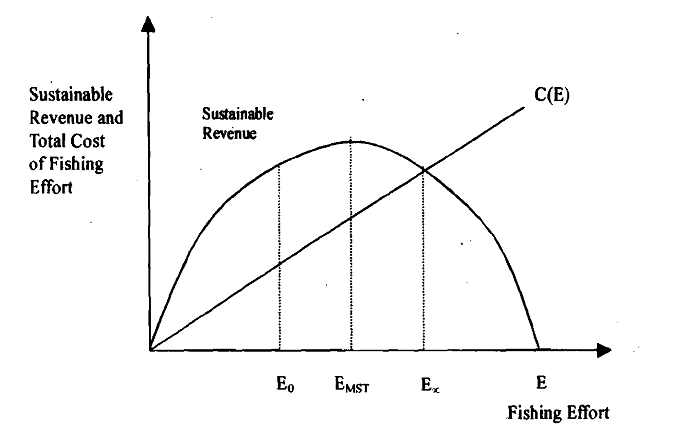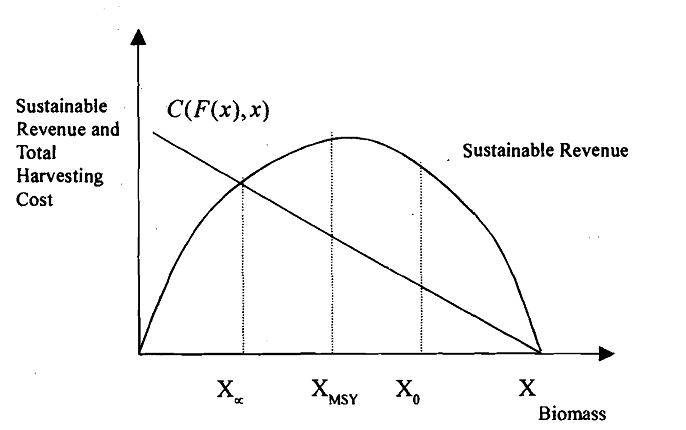A Model of Fishery: Bionomic Model
When we talk about fishery, the stock is the population of fish, measured either in numbers or in 'biomass', i.e., weight. The flow is the change in stock over a period of time. The changes can occur either due to biological factors such as birth and death, and due to human intervention such as harvesting. Schaefer (1957) has used the logistic biological growth function for fish to find the biological equilibrium that corresponds to maximum yield. The logistic growth function discussed in the earlier section is
Equation 1

The net growth of the biomass is
Equation 2
x = F (X) - h (t)
Where, F(x) is the net natural rate of growth, h(t) is the harvest rate and r is 'intrinsic' percentage growth rate. When F(X) is equal to h(t), then the stock is kept intact. Therefore, such harvesting is known as sustainable harvest and the yield is sustainable yield. In many species, there exists a critical or threshold level of population. If at any time population goes below this threshold level due to over- harvesting, then subsequently the stock would decline and finally reach zero. This is the situation where we have extinction of a species.
Given the sustainable harvest, the biological equilibrium is represented by the point, at which the net growth is maximum. This point corresponds to maximum sustainable yield (MSY). The model developed by Schaefer did not consider economic variables. Scott Gordon was the first one to introduce 'Economics of Fishery' in the Schaefer's model. This is known as Bionomic model.
Gordon introduced cost of harvesting which is a function of the effort level and assumed constant price. The sustainable yield curve can be transformed into sustainable revenue curve by multiplying with the price of fish. The difference between sustainable revenue and total cost of effort is defined as sustainable resource rent. Gordon developed two hypotheses:
1. The optimal size of fishery is the one, which maximizes sustainable resource rent.
2. If fishery is competitive and is subject to ‘no control', then harvesting will expand up to the point at which resource rent is completely dissipated.
The first hypothesis is based on the results of standard welfare economics theory where the optimum is determined by the intersection of marginal cost (MC) and marginal revenue (MR) at which resource rent is the maximum. In Figure, this point is E0. The second hypothesis is the result of 'tragedy of commons’. The common property nature of the resource will expand the harvesting until the resource rent totally vanishes. This is known as ‘bionomic equilibrium'. In Fig. 10.4 this point is E∞. Since there is no single private owner for the resource, everyone will try to appropriate as much rent as possible. Given that fishery is competitive, fishing will continue as long as rent is earned. It stops only when rent is zero. The level of fishery at this point is always greater than the socially optimal level where resource rent is maximized. Gordon argues that fishery will expand beyond a socially optimal level, if common property fishery is subject to no control. The corresponding stock levels are shown as X∞ and X0 in figure.

Figure: Bionomic Equilibrium Effort and Sustainable revenue

Figure: Bionomic Equilibrium Population and Sustainable Revenue